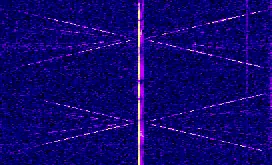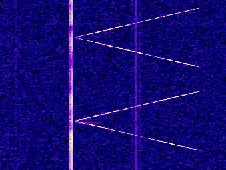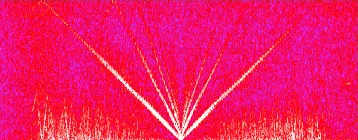XDE is a unique station that had very rarely transmitted. It’s use is still unknown, though its most likely it could be used for transmitter testing. This station was last noticed on January 6th, 2014. It continuously transmitted a triangular-like wave signal on 8000 kHz. It has been heard a few times before this date on the other frequencies shown below.
Recording
After it finished its long broadcast, a carrier remained for days. A constant dashing signal began once more remained at 8000 kHz, again for many days. Its use is still unknown. It was given the ID XDE since it was named after the Doppler Effect. The sound the station transmits sounds familiar to the pattern that a Doppler effect makes.
Another possible XDE broadcast was also captured by RW Observer on February 4th, 2014. Although it did not have the same waterfall pattern, the noise was very similar.
XDE was most recently heard on June 28th, 2015 on 4125, 6215, 8414, 12290, 12577, and 13500 kHz.
 |
 |
Station Summary
NSRIC ID: XDE
Activity: Inactive
Emission Mode: AM, USB
Frequency: 8000 kHz, Multiple
Additional Information
Written by Token,
We will likely never be able to prove what this is, but we can make some educated guesses.
What I am fairly sure it is not, is a radar. However, mistaking this signal for radar is not a new thing, it seems like every swept signal you find on HF gets called a radar at one time or another by someone. This same signal, or one very much like it, was reported in 2012 and 2013 on various frequencies , including 7001.5 and 12000 kHz. If you search for a pdf called “Radar systems on Shortwave”, by DK2OM (there are 2 versions of this paper, 2012 and 2013), you will see he mentions (in the Israel section) something that is probably this signal and ask the question of if it could be a new radar. However, he only asks the question, he never states it is an OTHR.
OK, why is it unlikely to be a radar?
First, look at the waveform itself. It consist of a triangle wave swept signal (DK2OM calls it a sawtooth wave, but it is in fact triangle, even in his images). You will find no current or past HF radar using a triangle wave sweep. This does not mean that a radar could not use such a sweep, but the reason it is generally not used is there are several shortcomings to such a waveform. To go into detail for all the problems with such a waveform would require a fairly lengthy tome, but the biggest single reason is that at the change of direction points (both high and low frequency ends) Doppler value / returns from the target are lost or become ambiguous. In affect you throw away some of your target return energy. Depending on the sweep rate and the radial velocity of the target this can end up being a large portion of all of your returns. This is why most FMCW radars do, in fact, use a real sawtooth wave sweep, with a sawtooth this problem does not exist.
Second, look at the audio tone of the sweep. Particularly pay attention to the tone at the low audio frequency end. The tone has a rough or slightly raspy quality to it. This is because the change rate of the audio tone is not smooth, but rather appears to be stepped. If it is indeed stepped, even micro stepped, the energy is near useless for FMCW radar applications….it is NOT FMCW at that point. For processing purposes it becomes a series of pulses, each on a slightly different frequency, and it has none of the advantages of an FMCW radar, and all of the disadvantages of a simple pulsed radar, plus the added complexity of the stepped frequency processing.
Third, and last for now, although there are several more reasons that could be brought up, look at the transmission itself, particularly the screen shot of the waterfall. For at least part of the time, if not all of the time, it was a full AM signal consisting of LSB, USB, and full carrier. The fact that the USB and LSB images and information appear to be identical indicates it is in fact DSB (Double Sideband) with full carrier, or good old AM, just like most shortwave and mediumwave broadcasters use. No radars use a waveform like this. It is extremely wasteful of energy (more energy is in the carrier than in the intelligence) and has no positive aspects to support its use in a radar.
So, if not a radar, what is it? Like I said, we may never be able to prove or disprove what it might or might not be. However, my bet is that it is a triangle wave swept audio test tone being injected into a transmit facility to test the audio modulator or transmitter itself. Such a signal is often useful to determine the audio passband of the transmitter. This action is called, simply enough, “sweeping” the passband. Looking closely at this signal you will see it is a triangle wave with about 5 kHz of sweep width occurring every 6 seconds. I have used such signals myself to test transmitters.





